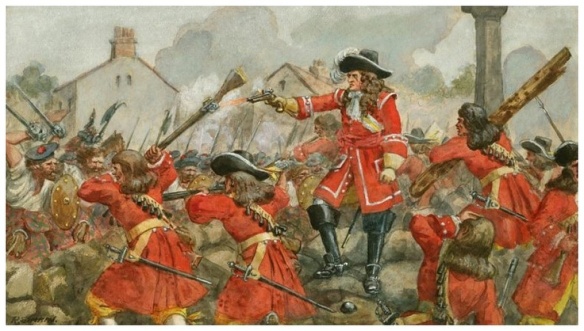William Cleland commanding the Williamite forces during the battle.
Killiecrankie may have been a costly victory, but having become part of Jacobite legend, it was enough to encourage continuing resistance in the Highlands. In August 1689 the Cameronian Regiment, which was garrisoned at Perth, marched to Dunkeld at the entrance to the Highlands and fought a battle in which a much smaller Williamite force, numbering 800 and consisting mostly of the inexperienced Cameronians, blocked the advance of a much larger Jacobite force of at least 3,000 men led by the Irish general, Alexander Cannon. The Jacobite army included remnants of Dundee’s army and the Atholl Highlanders who had deserted their colonel, James, Lord Murray. The Jacobites were still able to field an army the next spring led by Major-General Thomas Buchan, but their resistance to the Williamite conquest of Scotland was ended by the Battle of Cromdale, near the modern Grantown-on-Spey, on 1 May 1690.
Following the death of Viscount Dundee in the Jacobite victory at the Battle of Killiecrankie command of the Jacobites was passed to Colonel Alexander Cannon, leader of the recruits from Ireland, as opposed to the veteran sixty-year-old Sir Ewen Cameron of Lochiel, one of the most formidable Highland chiefs. Cameron was so insulted he left, taking some of his clan with him. With the Scottish Privy council preparing to leave Scotland in the wake of an expected Jacobite onslaught, the council ordered the newly formed Cameronian regiment under the command of Lieutenant Colonel William Cleland, to move north from Perth and to hold onto Dunkeld at all costs.
Dunkeld was not protected by a town wall, so Cleland ordered his troops to take up defensive positions in the cathedral, which was surrounded by an enclosing wall, and the nearby mansion of the Marquess of Atholl. The Jacobites, outnumbering the Cameronians four to one, stormed into attack from all sides – but in the narrow, winding streets there was no room for this type of Highland charge that succeeded in Killiecrankie. Thus, for sixteen hours the battle raged, as many who had barricaded themselves into houses were locked in and burned alive. Gradually the Cameronians were forced back, but at 11pm, depleted of energy and ammunition, the Highlanders decided to call it a day and withdrew, leaving 300 of their men dead or dying in the town. Having exhausted their own munitions, the Cameronians are reported to have stripped lead from the roof of Atholl House to keep up their fire. Holes dating from this battle, caused by the strikes of musket balls, are still visible in the east gable of Dunkeld Cathedral. The battle was over, and the Cameronian Covenanters could claim a war-winning victory.
The Colonel, William Cleland, only 27 years old but already a veteran hero of the Covenanter cause, died heroically in the first hour of battle by taking one bullet in the liver and another in the head, before dragging himself out of sight so that his men would not see him fall. The Major of the regiment was also wounded so that command fell to Captain George Munro of Auchinbowie who led them to victory.
The Jacobites routed, having lost around 300 men. Losses on the government side are unclear, but included Colonel Cleland, who is buried in the cathedral.
In the event the Battle of Killiecrankie and its aftermath at Dunkeld marked the beginning rather than the end of armed conflict in Scotland. Some had reasoned, along with the London merchants Francis Barrington and Benjamin Steele, that with Viscount Dundee “being killed in a late battle” and the Highlanders having “received so many routs,” things in Scotland were “in a fair way of settlement.” This was not to be. It was soon clear to a variety of commentators that the struggle to establish the new regime was far from over in Scotland. James Hay remarked to the Earl of Tweeddale that far from marking “the ruin of the Dundee party,” the Jacobites had “grown more numerous” since the Battle of Killiecrankie. Robert Kirk of Aberfoyle thought that had James followed up Killiecrankie with a landing, he could have taken control of Edinburgh and played “a far better game” than he did in Ireland. In fact, in December James ordered General Thomas Buchan to the Highlands, where he was assured there “a great many friends” who could be influenced to “rise for the king.” By early 1690 most keen observers were of the opinion that though “things are at present quiet in Scotland,” it was “certain there is a great ferment and discontent there.” The violent struggle to establish the revolution in Scotland, as in England, had not ended at Killiecrankie. It had entered a new phase.
